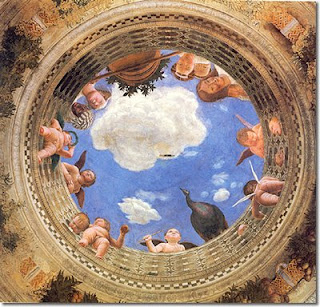The idea of Futurescope is that it would be like looking through a distorting mirror and would not be like looking at a 'normal' picture.
John and I wanted Futurescope to have something of this about it as if , when you looked, it might appear to be looking through a hole in the building itself towards a distant framed vision of a future landscape and environment.
We were thinking about reflecting pools, we were thinking about telescopes, we were thinking about distorting mirrors and we were thinking about technology. There are some great panoramas of Mars that have this distant and remote manipulated character about them. The odd thing is that a very small machine made the baseline imagery from which these images are composed but it is possible to imagine, whilst looking at them, that the machine is big in relation to the planet it is photographing!

We liked the idea of a distorting ‘Trompe l’oeil’ effect so that when people saw the picture it would not have the usual pictorial impact but would still have recognisable content. We also wanted to deal with how the image could be ‘composed’ in relation to a circular shape.
Trompe l’oeil means ‘a blow to the eye’ - a term used in art to describe a picture that is so ‘real’ it can deceive people into thinking that they are looking at real things and it has a great tradition of being used in paintings that relate to architecture.
At some point in these discussions one of John's assistants came up with a device that would manipulate the polar co-ordinates of square photographs and turn them into circles. So we started working with the idea.
One of John's photographs of the sky with meadow grass in the foreground really hit the spot and this was the starting point for the first image. It makes a great comparison with the Martian picture!

Then we got back to talking about energy crops - finally - settling on Sunflowers.





